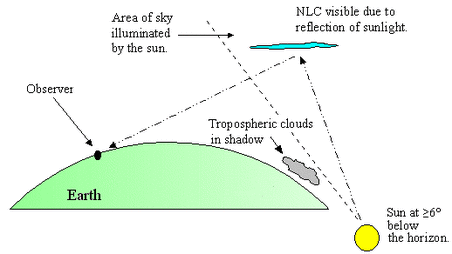"The 2013 season is remarkable because it started in the northern hemisphere a week earlier than any other season that AIM has observed," reports Cora Randall of the Laboratory for Atmospheric and Space Physics at the University of Colorado. "This is quite possibly earlier than ever before."

This diagram shows why
NLCs are best seen at
sunset or sunrise.
For sky watchers, this means it's time to pay attention to the sunset sky, where NLCs are most often seen. An early start could herald brighter clouds and wider visibility than ever before.
Noctilucent clouds were first noticed in the mid-19th century after the eruption of super-volcano Krakatoa. Volcanic ash spread through the atmosphere, painting vivid sunsets that mesmerized observers all around the world. That was when the NLCs appeared. At first people thought they must be some side-effect of the volcano, but long after Krakatoa's ash settled the noctilucent clouds remained.
"They've been with us ever since," says Randall. "Not only that, they are spreading."
When AIM was launched in 2007, the underlying cause of NLCs was still unknown. Researchers knew they formed 83 km above Earth's surface where the atmosphere meets the vacuum of space--but that's about all. AIM quickly filled in the gaps.
"It turns out that meteoroids play an important role in the formation of NLCs," explains Hampton University Professor James Russell, the principal investigator of AIM. "Specks of debris from disintegrating meteors act as nucleating points where water molecules can gather and crystallize."
The above diagram shows why NLCs are best seen at sunset or sunrise. NLCs appear during summer because that is when water molecules are wafted up from the lower atmosphere to mix with the "meteor smoke." That is also the time when the upper atmosphere is ironically coldest.
Back in the 19th century, NLCs were confined to high latitudes. You had to go to Alaska or Scandinavia to see them. In recent years, however, they have been sighted as far south as Utah, Colorado, and Nebraska. Some researchers believe that the spread of NLCs is a sign of climate change.
One of the greenhouse gases that has become more abundant in Earth's atmosphere since the 19th century is methane. "When methane makes its way into the upper atmosphere, it is oxidized by a complex series of reactions to form water vapor," says Russell. "This extra water vapor is then available to grow ice crystals for NLCs."
The early start of the 2013 season appears to be caused by a change in atmospheric “teleconnections.”
“Half-a-world away from where the northern NLCs are forming, strong winds in the southern stratosphere are altering global circulation patterns,” explains Randall. "This year more water vapor is being pushed into the high atmosphere where NLCs love to form, and the air there is getting colder."
"All of this has come as an interesting surprise for us," notes Russell. "When we launched AIM, our interest was in the clouds themselves. But now NLCs are teaching us about connections between different layers of the atmosphere that operate over great distances. Our ability to study these connections will surely lead to new understanding about how our atmosphere works."
Credits: Author: Dr. Tony Phillips | Production editor: Dr. Tony Phillips | Credit: Science@NASA
 RSS Feed
RSS Feed